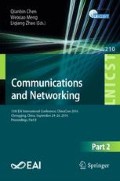Abstract
Cellular network can use renewable energy through energy harvesting technology in green communication. In this paper, power allocation for heterogeneous cellular networks (HetNets) with energy harvesting is proposed to maximize the system energy efficiency. Considering the minimal transmit rate of the users and the battery capacity of the system, a low complexity power allocation algorithm based on fractional programming is proposed to maximize the energy efficiency of the system. Simulation results demonstrate the effectiveness of the proposed algorithm.
This work was partially supported by the National Natural Science Foundation of China (No. 11502039), Scientific and Technological Research Program of Chongqing Municipal Education Commission (No. KJ1600424), PhD research startup foundation of Chongqing University of Posts and Telecommunications (No. A2015-41), and the Science Research Project of Chongqing University of Posts and Telecommunications for Young Scholars (No. A2015-62).
References
Hossain, E., Hasan, M.: 5G cellular: key enabling technologies and research challenges. IEEE Instrum. Meas. Mag. 18(3), 11–21 (2015)
Liu, D.T., Wang, L.F., et al.: User association in 5G networks: a survey and an outlook. IEEE Commun. Surv. Tutor. 18(2), 1018–1044 (2016)
Yang, H.H., Lee, J., Quek, T.Q.S.: Heterogeneous cellular network with energy harvesting-based D2D communication. IEEE Trans. Wirel. Commun. 15(2), 1406–1419 (2016)
Diamantoulakis, P.D., Pappi, K.N., Karagiannidis, G.K., Poor, H.V.: Autonomous energy harvesting base stations with minimum storage requirements. IEEE Wirel. Commun. Lett. 4(3), 265–268 (2015)
Zhang, T., Xu, H., Liu, D., Beaulieu, N.C., Zhu, Y.: User association for energy-load tradeoffs in Hetnets with renewable energy supply. IEEE Commun. Lett. 19(12), 2214–2217 (2015)
Gong, J., Zho, S., Zhou, Z., Niu, Z.: Downlink base station cooperation with energy harvesting. In: 2014 IEEE International Conference on Communication Systems (ICCS), Macau, pp. 87–91 (2014)
Reyhanian, N., Maham, B., Shah-Mansouri, V., Yuen, C.: A matching-game-based energy trading for small cell networks with energy harvesting. In: 2015 IEEE 26th Annual International Symposium on Personal, Indoor, and Mobile Radio Communications (PIMRC), Hong Kong, pp. 1579–1583 (2015)
Ng, D.W.K., Lo, E.S., Schober, R.: Energy-efficient resource allocation in OFDMA systems with hybrid energy harvesting base station. IEEE Trans. Wirel. Commun. 12(7), 3412–3427 (2013)
Mao, Y., Zhang, J., Letaief, K.B.: A lyapunov optimization approach for green cellular networks with hybrid energy supplies. IEEE J. Sel. Areas Commun. 33(12), 2463–2477 (2015)
Gorlatova, M., Wallwater, A., Zussman, G.: Networking low-power energy harvesting devices: measurements and algorithms. In: Proceedings of IEEE International Conference on Computer Communications (INFOCOM), Shanghai (2011)
Dinkelbach, W.: On nonlinear fractional programming. Manag. Sci. 13, 492–498 (1967)
Schaible, S., Ibaraki, T.: Fractional programming. Eur. J. Oper. Res. Int. J. 12(4), 325–338 (1983)
Boyd, S., Mutapcic, A.: Subgradient Methods. Notes for EE364b, Stanford University (2007)
Author information
Authors and Affiliations
Corresponding author
Editor information
Editors and Affiliations
Appendix A
Appendix A
Energy use and storage conditions C1 and C2 can be derived as follows. Let \(S_{i,n}={\overline{\mathop L\nolimits _E } \left( {\mathop p\nolimits _{i,n}^R + \mathop p\nolimits _{i,n}^O } \right) }\) be the energy used for femtocell n in time slot i. Then, for time slot 1 to K, we have following inequality constraints.
therefore \(\mathrm{{ }}\mathop S\nolimits _{j,n} \mathrm{{ \le }}\sum \nolimits _{i = 0}^j {\mathop E\nolimits _{i,n} } - \sum \nolimits _{i = 1}^{j - 1} {\mathop S\nolimits _{i,n} } \) is hold for \(j=1,\cdots , K\), move the item \(\sum \nolimits _{i = 1}^{j- 1} {\mathop S\nolimits _{i,n} } \) from the right side to the left side, we have
substitute \(S_{i,n}={\overline{\mathop L\nolimits _E } \left( {\mathop p\nolimits _{i,n}^R + \mathop p\nolimits _{i,n}^O } \right) }\) into (11), we have
Therefore C1 is hold. Meanwhile, because capacity limit of the battery, the remaining battery energy in each time slot for femtocell n cannot exceed the battery capacity, more than part of the energy will be discarded:
for each time slot \(j=1,\cdots ,K\),then we have
Therefore C2 is hold.
Rights and permissions
Copyright information
© 2018 ICST Institute for Computer Sciences, Social Informatics and Telecommunications Engineering
About this paper
Cite this paper
Wan, X., Feng, X., Wang, Z., Fan, Z. (2018). Power Allocation Algorithm for Heterogeneous Cellular Networks Based on Energy Harvesting. In: Chen, Q., Meng, W., Zhao, L. (eds) Communications and Networking. ChinaCom 2016. Lecture Notes of the Institute for Computer Sciences, Social Informatics and Telecommunications Engineering, vol 210. Springer, Cham. https://doi.org/10.1007/978-3-319-66628-0_4
Download citation
DOI: https://doi.org/10.1007/978-3-319-66628-0_4
Published:
Publisher Name: Springer, Cham
Print ISBN: 978-3-319-66627-3
Online ISBN: 978-3-319-66628-0
eBook Packages: Computer ScienceComputer Science (R0)

